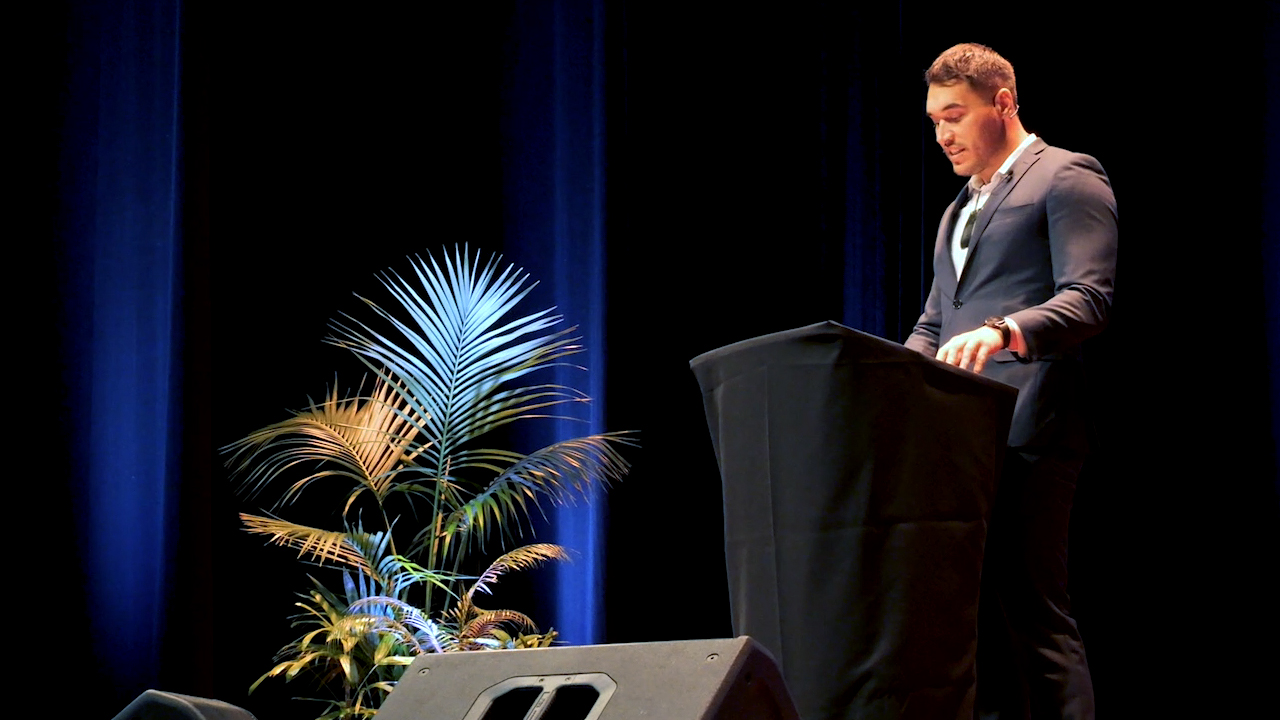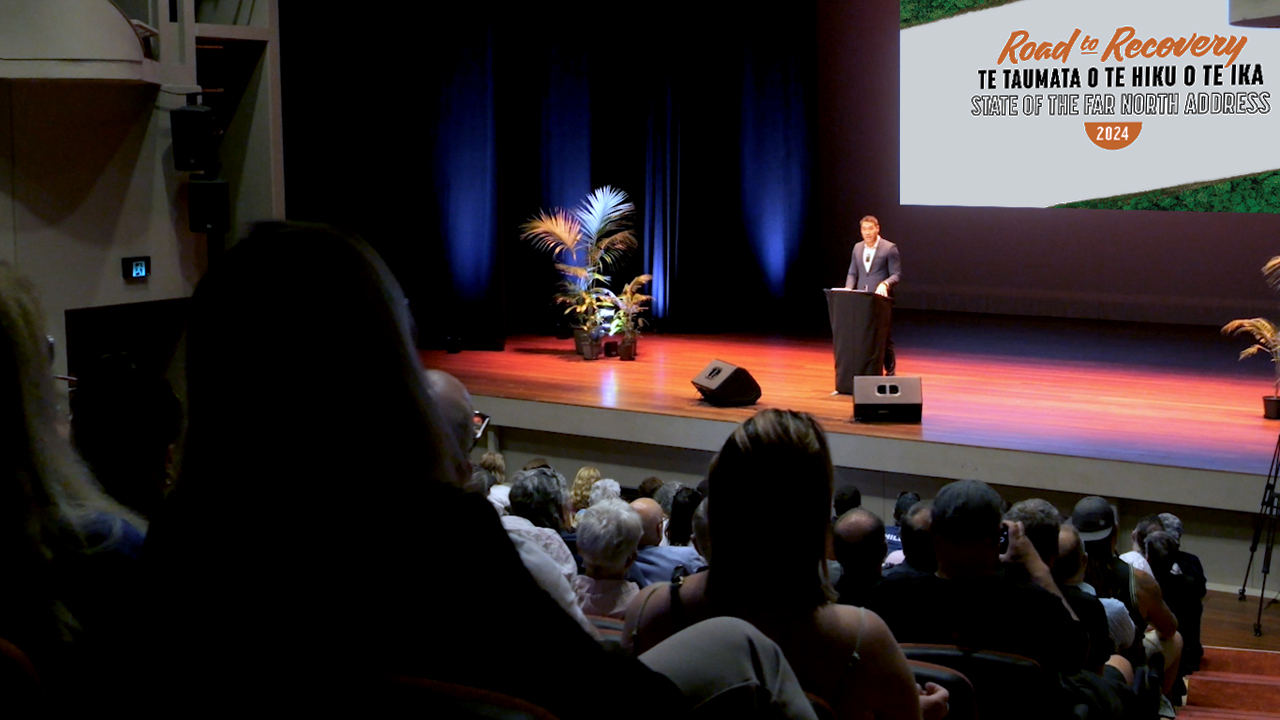VIDEO - Future of the Far North takes centre stage

More than 200 people from across the district and as far away as Auckland gathered at Kerikeri’s Turner Centre on Tuesday night (12 November) to witness the council’s inaugural State of the Far North address.
The event, delivered by Far North Mayor, Moko Tepania, was an opportunity for business, community, political and Te Ao Māori representatives to network and to hear how Far North District Council is addressing multiple challenges posed by recent weather events and economic shifts.
Far from being a typical council ‘Town Hall’ meeting, the Road to Recovery address – the first of its kind in New Zealand – was a fast-paced, information-rich presentation that combined videos, humour, and a dash of honesty to change the narrative on the council’s work and to reconnect with Far North residents.
"The event was the opportunity for us to share the new direction this council is taking to respond to a number of significant challenges and to be transparent about it," Kahika Tepania told media covering the presentation. "It's about what we're recovering from, where we are at now, and what's up ahead."
The immense challenges faced by the council in recent years were highlighted. These include severe drought, Covid-19 lockdowns, and at least 10 separate significant weather events between July 2022 and February 2023. As well as outlining the challenges, the mayor detailed how the council had responded and how those events had changed the way it does business.
Immediately after being hit by Cyclone Gabrielle and other weather events, the council was faced with 175 slips to repair at an estimated cost of $41 million. Kahika Tepania told the audience that asking ratepayers to pay that bill would equate to a 41 per cent rates rise. That was avoided due to the financial support provided by central government.
But in a real landmark for our council, the Far North ended up with the lowest rates increase in the country at 4.5 per cent for the 2024-25 financial year thanks to a "new way of doing things" and a $5 million dividend from Far North Holdings Ltd.
That was also despite having a very low rating base. He revealed that of the 71,000 people living in the Far North, only 28,000 are ratepayers, representing just 39 per cent of the district’s population.
He conceded that the district has benefitted from central government funding with a number of high-profile projects financed after the Covid-19 pandemic. Those include the revitalisation of Te Hiku, a new boardwalk at Mangōnui, two new animal shelters, a sports hub for Kerikeri, upgrades to the Kerikeri Domain, and several maritime facility upgrades. He also reflected that some government decisions had added challenges to life in the Far North, including repeal of Three Waters legislation and uncertainty over the futures of the Resource Management Act and Māori wards.
During the address, the mayor revealed how the council had empowered the decision making of council committees, developed wellbeing strategies, and had focused on creating stronger partnerships.

Along with other Northland councils, Far North District Council had also disestablished the Northland Transportation Alliance to bring its roading team back in-house so staff could focus on the unique, day-to-day challenges facing the Far North. In its Long Term Plan 2024-27, the council had allocated $153 million to be spent over the next three years keeping the district's roads maintained. And despite keeping total rate increases to a minimum, the council has a significant capital works programme planned with more than $192 million in expenditure allocated. In the first three months of this financial year, $7.1 million has been spent on roads and footpaths, $8.7 million on water supplies, $3.9 million on district facilities, $2.3 million on wastewater, and another $1.7 million on miscellaneous projects. He added that as much as 50 per cent of that spending will go directly into the local economy.
Customer services – or how the council deals directly with ratepayers – are also improving. That includes a significant increase in the percentage of enquiries resolved at the first point of contact – now up to 90 per cent. At the same time, the council is reducing operating costs by bringing after-hours telephone support in-house instead of paying an external service provider, and combining service centres with libraries where possible.
The presentation also revealed important updates to long-term projects, including the future of Kaitāia Airport, the Kaitāia Water Project at Sweetwater, new design concepts for the Kaikohe Library and Civic Hub, Procter Library changes, and the Kerikeri-Waipapa Spatial Plan.
He finished the hour-long address by calling on all Far North residents to get more involved with the work of the council. “Come to our consultation events, watch our livestreamed meetings, raise Requests for Service for the things we need to know about… ‘cos I can tell you right now, comments on Facebook won’t get you anywhere. We need you participating in the democratic process, turning up, and tuning in.”
Looking ahead, the State of the Far North Address will become an annual event, ensuring accountability for the commitments made and providing a transparent update on the progress Council has achieved. It will also serve as an ongoing platform to keep residents informed about the challenges the Far North District Council faces and the actions it is taking to build a stronger, more resilient Far North.
Watch the full presentation on YouTube:

